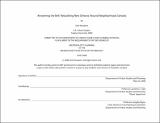| dc.contributor.advisor | Lawrence J. Vale. | en_US |
| dc.contributor.author | Knudsen, Seth (Seth Cunningham) | en_US |
| dc.contributor.other | Massachusetts Institute of Technology. Dept. of Urban Studies and Planning. | en_US |
| dc.coverage.spatial | n-us-la | en_US |
| dc.date.accessioned | 2009-01-26T22:01:20Z | |
| dc.date.available | 2009-01-26T22:01:20Z | |
| dc.date.copyright | 2008 | en_US |
| dc.date.issued | 2008 | en_US |
| dc.identifier.uri | http://hdl.handle.net/1721.1/44204 | |
| dc.description | Thesis (M.C.P.)--Massachusetts Institute of Technology, Dept. of Urban Studies and Planning, 2008. | en_US |
| dc.description | This electronic version was submitted by the student author. The certified thesis is available in the Institute Archives and Special Collections. | en_US |
| dc.description | Includes bibliographical references (p. 89-91). | en_US |
| dc.description.abstract | Schools are one of the most important and visible infrastructure elements in residential neighborhoods, given their large physical presence and the social network that they represent. A review of real estate, sociology, and urban design research suggests that neighborhoods and residents benefit in a variety of ways from proximity to a well-maintained school of good quality. Not surprisingly, New Orleans residents have identified schools as critical elements in the recovery of their neighborhoods in the myriad of post-Katrina planning processes. In this context, residential rebuilding decisions in substantially flood damaged neighborhoods may be influenced by the status of the neighborhood school. As residential redevelopment patterns begin to emerge in spring 2008, the master planning process for the public school system is underway. While the public school system was responsible for the education of nearly 66,000 students at 126 campus locations across the city prior to Katrina, private schools provided an educational option for 26,000 other students at 79 campuses citywide. Nearly seventy percent of private school students attended Catholic schools managed by the Archdiocese of New Orleans. In contrast to the public school system that has taken nearly three years to chart its course for the future, the Catholic school system made decisions about which schools would reopen by February 2006, less than six months after the flood. In this study, parochial elementary schools run by the Archdiocese of New Orleans are used as a proxy for the public school system to examine the effects of neighborhood schools on residential rebuilding. | en_US |
| dc.description.abstract | (cont.) Residential building permits issued within half, quarter, and tenth mile radii of parochial elementary schools in substantially flood damaged neighborhoods are compared with the number of residential lots to calculate a crude rebuilding rate. The hypothesis is that neighborhoods around schools that have reopened will exhibit higher rates of residential rebuilding. The findings do not support the hypothesis, but instead support a correlation between the location of residential rebuilding and neighborhood school status. While overall rebuilding rates within a half mile radius of open and closed schools are comparable, most redevelopment activity tends to be concentrated in close proximity to schools that have reopened and further away from schools that remain closed. Given the potential of rebuilt schools to attract development, school facility planners should work with the city to identify which pre-Katrina school locations would be most advantageous for post-Katrina development clusters. | en_US |
| dc.description.statementofresponsibility | by Seth Knudsen. | en_US |
| dc.format.extent | 91 p. | en_US |
| dc.language.iso | eng | en_US |
| dc.publisher | Massachusetts Institute of Technology | en_US |
| dc.rights | M.I.T. theses are protected by
copyright. They may be viewed from this source for any purpose, but
reproduction or distribution in any format is prohibited without written
permission. See provided URL for inquiries about permission. | en_US |
| dc.rights.uri | http://dspace.mit.edu/handle/1721.1/7582 | en_US |
| dc.subject | Urban Studies and Planning. | en_US |
| dc.title | Answering the bell : rebuilding New Orleans around neighborhood schools | en_US |
| dc.title.alternative | Rebuilding New Orleans around neighborhood schools | en_US |
| dc.type | Thesis | en_US |
| dc.description.degree | M.C.P. | en_US |
| dc.contributor.department | Massachusetts Institute of Technology. Department of Urban Studies and Planning | |
| dc.identifier.oclc | 276877668 | en_US |
